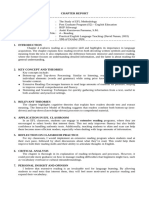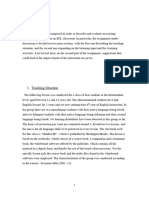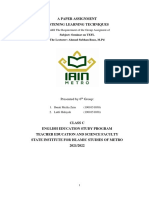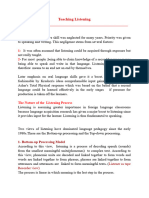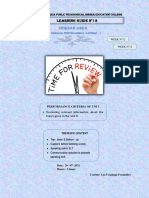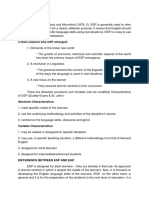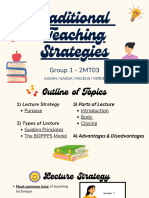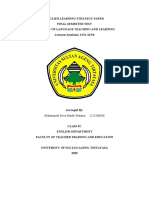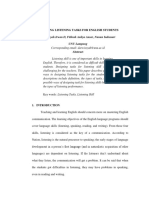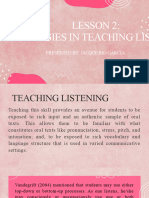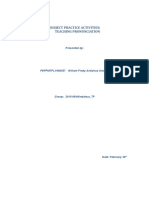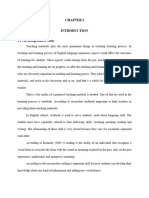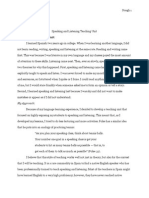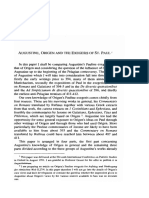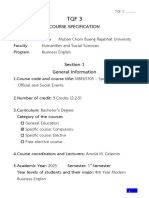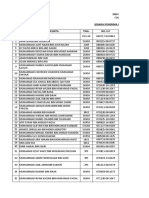Chapter Report - Chapter 1 - Andri Kurniawan Purnama, S.PD
Chapter Report - Chapter 1 - Andri Kurniawan Purnama, S.PD
Uploaded by
Andri KurniawanCopyright:
Available Formats
Chapter Report - Chapter 1 - Andri Kurniawan Purnama, S.PD
Chapter Report - Chapter 1 - Andri Kurniawan Purnama, S.PD
Uploaded by
Andri KurniawanOriginal Title
Copyright
Available Formats
Share this document
Did you find this document useful?
Is this content inappropriate?
Copyright:
Available Formats
Chapter Report - Chapter 1 - Andri Kurniawan Purnama, S.PD
Chapter Report - Chapter 1 - Andri Kurniawan Purnama, S.PD
Uploaded by
Andri KurniawanCopyright:
Available Formats
CHAPTER REPORT
1. Course : The Study of EFL Methodology
2. Program : Post Graduate Program (S2) – English Education
3. Institution : IKIP Siliwangi
4. Student Name : Andri Kurniawan Purnama, S.Pd.
5. Chapter Number and Title : 2 – Listening
6. Source : Practical English Language Teaching (David Nunan, 2003)
7. Week and Date : 4th of October 2024
1. INTRODUCTION
Chapter two explores listening as one of the four language skills. This highlights listening as
an active process, one in which language learners should take what they hear and relate it back to
things we know from previously learnt information. It is framed in terms of an active skill, not just
the decoding of sounds or letters to gain sense from or meanings. This chapter presents important
principles of how to teach listening and actual strategies you can use with your learners to improve
their listening ability.
2. KEY CONCEPT AND THEORIES
This chapter discusses the following key concepts:
1. bottom-up processing –examination of individual aspects (e.g. vocabulary,grammar,, sounds) to
develop a cohesive understanding
2. Top- down Processing: Uses previous knowledge, life experiences and experience with what is
going on to understand the language heard.
3. Listening for Detail: The listening skills they must have in the test could include concentrating
on one or more specific items of information (for example, names, dates or times) rather than
just understanding a general message.
4. The World of Listening (Listening for Gist): This is understanding what the conversation will
be about or what has occurred in common everyday life situations.
5. Inference = reading between the lines, using what we know to make educated guesses as to
their meaning.
3. RELEVANT THEORIES
The chapter discusses theories such as Rumelhart and Ortony's (1977) bottom-up and top-down
processing models, and Krashen's Input Hypothesis (1985). These theories emphasize that effective
language learning necessitates exposure to input slightly beyond learners' current abilities, thereby
facilitating the gradual acquisition of new linguistic items.
4. APPLICATION IN EFL CLASSROOM
This chapter suggests using a variety of listening tasks, such as listening for specific details,
inferring meaning, and understanding the main point of a conversation. For example, teachers
might include activities such as identifying key information in a conversation or asking students to
predict content based on contextual clues. A common task is listening to a weather forecast and
extracting specific details, such as temperature or weather conditions.
5. REFLECTION ON CLASSROOM PRACTICE
When I apply this method in my EFL classes, I start with a pre-class activity that activates
students’ background knowledge. For example, before playing the listening passage, I might have
students brainstorm vocabulary related to the topic. This will help them recognize keywords and
understand the content more easily.
6. CRITICAL ANALYSIS
This chapter provides a comprehensive description of the listening process, but more practical
examples may be helpful for lower-level learners who may struggle to use real-world listening
materials. There is also a strong emphasis on a variety of tasks, but little discussion of how to
effectively balance different types of listening within a lesson.
7. PERSONAL INSIGHT AND OPINION
I agree with this chapter’s emphasis on integrating top-down and bottom-up processing. In my
experience, students benefit from tasks that combine both approaches, allowing them to focus on
specific details and overall meaning. However, I think that beginners who are just beginning to
learn a second language may need more support.
8. CONCLUSION
Chapter 2 emphasizes the important role of listening in language acquisition, describes key
processes, and provides practical strategies for the classroom. By combining bottom-up and top-
down approaches, teachers can help students become more effective listeners and ultimately
improve their overall language skills.
9. REFERENCES
Nunan, D. (2003). *Practical English Language Teaching*. McGraw-Hill.
You might also like
- Teaching English to Speakers of Other LanguagesFrom EverandTeaching English to Speakers of Other LanguagesRating: 3 out of 5 stars3/5 (1)
- Chapter Report 3 - Chapter 4 - Andri Kurniawan Purnama, S.PDDocument2 pagesChapter Report 3 - Chapter 4 - Andri Kurniawan Purnama, S.PDAndri KurniawanNo ratings yet
- Chapter Report - Chapter 6 - Andri Kurniawan Purnama, S.PDDocument2 pagesChapter Report - Chapter 6 - Andri Kurniawan Purnama, S.PDAndri KurniawanNo ratings yet
- AhDocument21 pagesAhDee EdNo ratings yet
- Chapter Report 2 - Chapter 3 - Andri Kurniawan Purnama, S.PDDocument2 pagesChapter Report 2 - Chapter 3 - Andri Kurniawan Purnama, S.PDAndri KurniawanNo ratings yet
- Unit 3: The Teaching and Learning of EFL Listening and ReadingDocument21 pagesUnit 3: The Teaching and Learning of EFL Listening and Readingelezabethdensina100% (1)
- Kapelaki Agg11 01 BDocument9 pagesKapelaki Agg11 01 BELPINIKIMUNo ratings yet
- Language Skills Development in The Efl ClassroomDocument191 pagesLanguage Skills Development in The Efl ClassroomDilbara KonurbaevaNo ratings yet
- The More He Hears, The Better He Speaks: The Better He Speaks, The Best He UnderstandsDocument40 pagesThe More He Hears, The Better He Speaks: The Better He Speaks, The Best He UnderstandsRo-elle Blanche Dalit CanoNo ratings yet
- Makalah Seminar On TEFLDocument9 pagesMakalah Seminar On TEFLLuthfiNo ratings yet
- ListeningDocument5 pagesListeningmslm9572No ratings yet
- Group 1 Leader: Darren Luklukan MembersDocument5 pagesGroup 1 Leader: Darren Luklukan MembersRoselyn RebañoNo ratings yet
- Zusatzmaterialien New Inspiration 3 - AufgabenDocument64 pagesZusatzmaterialien New Inspiration 3 - Aufgabenubaydullaevich97No ratings yet
- Lecture 03 Teaching and Assessing ListeningDocument3 pagesLecture 03 Teaching and Assessing ListeningnessrinedahmounNo ratings yet
- Learning Language Naturally-WishnoebrotoDocument8 pagesLearning Language Naturally-WishnoebrotoPusat Bahasa BandungNo ratings yet
- Listening Strategies and Applications in EFL Classroom: II. MotivationDocument34 pagesListening Strategies and Applications in EFL Classroom: II. MotivationCesar MartinezNo ratings yet
- Seminar Area: Learning Guide N°12Document7 pagesSeminar Area: Learning Guide N°12michis123No ratings yet
- PrinciplesDocument65 pagesPrinciplesantarNo ratings yet
- Lesson 4Document4 pagesLesson 4saint mary jane pinoNo ratings yet
- Lesson 7 ENGLISHDocument10 pagesLesson 7 ENGLISHJackaii Waniwan IINo ratings yet
- What Is Esp?Document5 pagesWhat Is Esp?Danlie BeraquitNo ratings yet
- Working Paper Lla AyuDocument12 pagesWorking Paper Lla AyudeviNo ratings yet
- TBL Mam AniDocument27 pagesTBL Mam AniSarah Tan GoNo ratings yet
- General Principles in Teaching Language SkillsDocument14 pagesGeneral Principles in Teaching Language SkillsElczah OliviaNo ratings yet
- Materials and Methods For Extensive List PDFDocument7 pagesMaterials and Methods For Extensive List PDFJoost ArxNo ratings yet
- Cousera Mooc 4Document5 pagesCousera Mooc 4Huynh Hai Son (K17 CT)No ratings yet
- Proposal Discovery LearningDocument11 pagesProposal Discovery Learningiwan bilautNo ratings yet
- Teaching Listening For Advanced LearnersDocument25 pagesTeaching Listening For Advanced LearnersMutiaRetnoMahartiNo ratings yet
- PST GRP 1 - Traditional Teaching StrategiesDocument27 pagesPST GRP 1 - Traditional Teaching StrategiesejNo ratings yet
- Chapter 1 PDFDocument4 pagesChapter 1 PDFZakiah KhyNo ratings yet
- Course Syllabus Ginst 003 2021 22Document3 pagesCourse Syllabus Ginst 003 2021 22Apolonio Jr Punzalan EspirituNo ratings yet
- English Learning Strategy Pape1Document10 pagesEnglish Learning Strategy Pape1Ikhsan Dinn IslamNo ratings yet
- English Learning Strategy Pape1Document10 pagesEnglish Learning Strategy Pape1Ikhsan Dinn IslamNo ratings yet
- Listening LSA1 Background EssayDocument15 pagesListening LSA1 Background EssayBen Eichhorn100% (2)
- Final TestDocument8 pagesFinal TestPhuong Nhung K47D-SPA BuiNo ratings yet
- TEACHING ORAL COMMUNICATION SKILLS - Wilmer ZambranaDocument15 pagesTEACHING ORAL COMMUNICATION SKILLS - Wilmer ZambranaWilmer Zambrana GuadamuzNo ratings yet
- Chapter I Riskamaulina Listening DictoglossDocument17 pagesChapter I Riskamaulina Listening DictoglossJamil AhNo ratings yet
- Modul Ajar Analytical Exposition FASE EDocument27 pagesModul Ajar Analytical Exposition FASE EHelena MumpuniNo ratings yet
- A Balanced Approach To English Discussions: Christopher MattsonDocument6 pagesA Balanced Approach To English Discussions: Christopher MattsonLaura NúñezNo ratings yet
- Jurnal 2019 JuniiiDocument14 pagesJurnal 2019 JuniiiaulNo ratings yet
- Chapter 2.TEACHING - Listening PDFDocument23 pagesChapter 2.TEACHING - Listening PDFEsther Ponmalar Charles91% (11)
- Strategies in Teaching ListeningDocument23 pagesStrategies in Teaching ListeningZiazel Asilo100% (1)
- Feedback by IMAS KURNIA SARI (19340016) UTS QUALITATIVE RESEARCH METHODDocument5 pagesFeedback by IMAS KURNIA SARI (19340016) UTS QUALITATIVE RESEARCH METHODIwayan Hendra Cahya NugrahaNo ratings yet
- Listening Comprehension Need and NeglectDocument8 pagesListening Comprehension Need and NeglectmychiefNo ratings yet
- Listening: Elements of Good ListeningDocument17 pagesListening: Elements of Good ListeningGuntur Nara PersadaNo ratings yet
- FinanceDocument6 pagesFinanceAbdinourNo ratings yet
- Worksheet 01Document6 pagesWorksheet 01william100% (1)
- Anita SitompulDocument29 pagesAnita SitompulTeguh Viras MannicNo ratings yet
- Teaching Strategies IV - Expository PresentationDocument22 pagesTeaching Strategies IV - Expository PresentationEzekiel D. Rodriguez100% (2)
- 126 157 Pendalaman Materi Bahasa Inggris PDFDocument206 pages126 157 Pendalaman Materi Bahasa Inggris PDFDaudSutrisno100% (2)
- Car Team 6 ContentDocument23 pagesCar Team 6 ContentDewitha Josephine Sembiring KembarenNo ratings yet
- Chapter Report 7 PEPIDocument8 pagesChapter Report 7 PEPIpepisilvia70No ratings yet
- Submitted As Partial Fulfillment of The Requirements For Getting Bachelor Degree of Education in English DepartmentDocument7 pagesSubmitted As Partial Fulfillment of The Requirements For Getting Bachelor Degree of Education in English DepartmentJessica Agodo LindaanNo ratings yet
- Lesson Plan 7Document104 pagesLesson Plan 7Myyne 30No ratings yet
- Module 3.2 - Listening and ReadingDocument18 pagesModule 3.2 - Listening and ReadingThuonggipNo ratings yet
- FP005 - TP - PracActiv - Co - en Marina Terrosi TEFL Feb 2018 OKDocument8 pagesFP005 - TP - PracActiv - Co - en Marina Terrosi TEFL Feb 2018 OKMarinaNo ratings yet
- Teaching Unit S LDocument5 pagesTeaching Unit S Lapi-297274147No ratings yet
- University of Foreign Language StudiesDocument21 pagesUniversity of Foreign Language StudiesThu UyenNo ratings yet
- SFL in Teaching ListeningDocument10 pagesSFL in Teaching ListeningZaenul WafaNo ratings yet
- 04 Group02 NguyenThiTrinh K62 AcademicWritingDocument18 pages04 Group02 NguyenThiTrinh K62 AcademicWritingphamthingocmai2003qhNo ratings yet
- Forms of Oral LiteratureDocument6 pagesForms of Oral LiteratureBedoAhmad100% (1)
- Project Synopsis PDFDocument11 pagesProject Synopsis PDFHarsh NegiNo ratings yet
- Decoder and EncoderDocument8 pagesDecoder and EncodersankulsybcaNo ratings yet
- Augustine, Origen and The Exegesis of PaulDocument28 pagesAugustine, Origen and The Exegesis of PaulOstapNo ratings yet
- Email Ar Invoices To CustomersDocument38 pagesEmail Ar Invoices To CustomersupmuthukumarmcomNo ratings yet
- HMI Seminar ReportDocument30 pagesHMI Seminar ReportNitinSharma67% (3)
- TQF3 - Speaking English in Official and Social EventsDocument17 pagesTQF3 - Speaking English in Official and Social Eventspinoy foreverNo ratings yet
- Central Mindanao Colleges - College of Education: Pre-Service Teacher'S Lesson PlanDocument3 pagesCentral Mindanao Colleges - College of Education: Pre-Service Teacher'S Lesson PlanHannahclaire Delacruz0% (1)
- Senarai Penerima Anugerah Colours Day 2022 TerkiniDocument19 pagesSenarai Penerima Anugerah Colours Day 2022 TerkiniHarithNo ratings yet
- Learning Guide U2 Lesson 3 1Document9 pagesLearning Guide U2 Lesson 3 1Kues MinsNo ratings yet
- Unit-3 22es14aDocument77 pagesUnit-3 22es14atejvimathNo ratings yet
- Programming in C 1: Overview of Computers and ProgrammingDocument22 pagesProgramming in C 1: Overview of Computers and Programmingdarwinvargas2011No ratings yet
- WH - Questions: 2. Fill in The Correct Question Word: 1. Choose and Underline The Correct Question WordDocument2 pagesWH - Questions: 2. Fill in The Correct Question Word: 1. Choose and Underline The Correct Question WordNidia Yaneth CéspedesNo ratings yet
- Rapunzel by The Grimm Brothers - A Comparison of The Versions of 1812 and 1857Document4 pagesRapunzel by The Grimm Brothers - A Comparison of The Versions of 1812 and 1857wicus1No ratings yet
- (John Kreiter) Manifest Wealth and Prosperity With Thought Forms and ServitorsDocument156 pages(John Kreiter) Manifest Wealth and Prosperity With Thought Forms and Servitorsenokiano1100% (2)
- Writing Techniques For Muet Statistical Report WritingDocument2 pagesWriting Techniques For Muet Statistical Report WritingCikgu Jessie U. UchatNo ratings yet
- 2024 - Youth Week Program GuideDocument8 pages2024 - Youth Week Program GuidepaulinemuswaloNo ratings yet
- Final Paper English XIDocument66 pagesFinal Paper English XIMuhammad Saad Bin RafaqatNo ratings yet
- Grade 10-Quarter 3 - DLPDocument8 pagesGrade 10-Quarter 3 - DLPLeah MatiasNo ratings yet
- Instant Download How to Read Your Way to Heaven A Spiritual Reading Program for the Worst of Sinners the Greatest of Saints and Everyone in Between Vicki Burbach PDF All ChaptersDocument55 pagesInstant Download How to Read Your Way to Heaven A Spiritual Reading Program for the Worst of Sinners the Greatest of Saints and Everyone in Between Vicki Burbach PDF All Chaptersnyiribuyckz0100% (2)
- VI SEM CSE CS1351 Artificial Intelligence UNIT-III Question and AnswersDocument18 pagesVI SEM CSE CS1351 Artificial Intelligence UNIT-III Question and AnswersPuspha Vasanth RNo ratings yet
- Instructional Plan in Araling Panlipunan-. 1 (12) : Elements of The PlanDocument6 pagesInstructional Plan in Araling Panlipunan-. 1 (12) : Elements of The PlanYares Mercedita L.No ratings yet
- 4357 02 Que 20070502Document8 pages4357 02 Que 20070502Abeera FaisalNo ratings yet
- Psychological Science Modeling Scientific Literacy 2nd Edition Krause Test Bank 1Document68 pagesPsychological Science Modeling Scientific Literacy 2nd Edition Krause Test Bank 1pa100% (62)
- Ofelia Garcia, Massimiliano Andrea Spotti, Nelson Flores - The Oxford Handbook of Language and Society-Oxford University Press (2017)Document585 pagesOfelia Garcia, Massimiliano Andrea Spotti, Nelson Flores - The Oxford Handbook of Language and Society-Oxford University Press (2017)Sharada Koti100% (9)
- Communication Skills NotesDocument54 pagesCommunication Skills NotessameerusbshsnsNo ratings yet
- Passive Voice: Form of Passive Subject + Object + To Be + Past Participle + Verb 3Document3 pagesPassive Voice: Form of Passive Subject + Object + To Be + Past Participle + Verb 3SoniaNo ratings yet
- Virtual History and The BibleDocument209 pagesVirtual History and The Bibleflannerybom75% (12)
- Brief History of The Bakossi PeopleDocument8 pagesBrief History of The Bakossi PeopleEwane MpodeNo ratings yet
- Loan PredictionDocument37 pagesLoan PredictionManashi DebbarmaNo ratings yet

